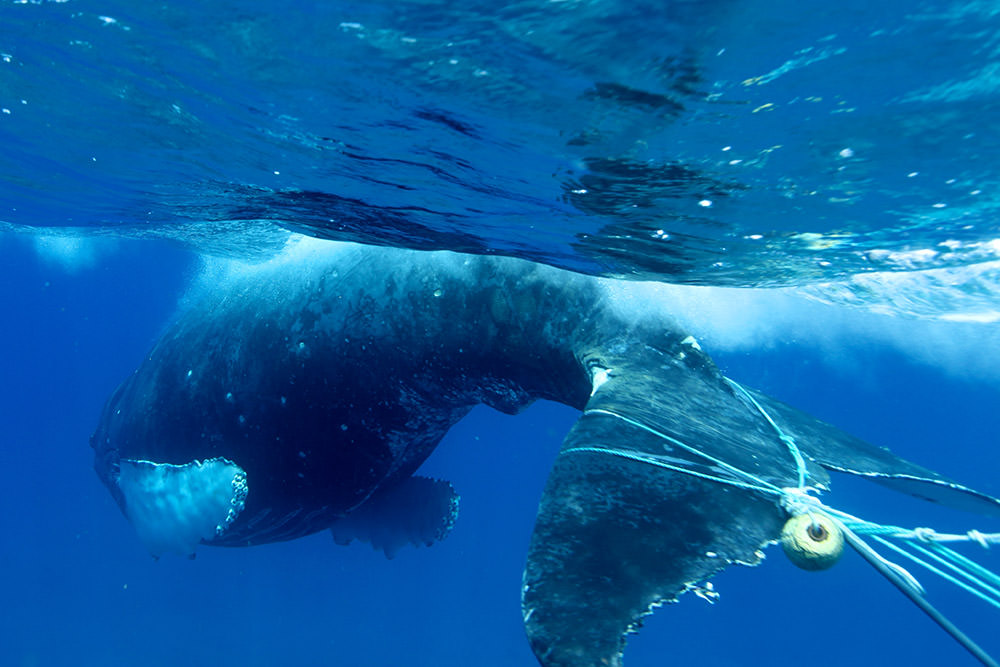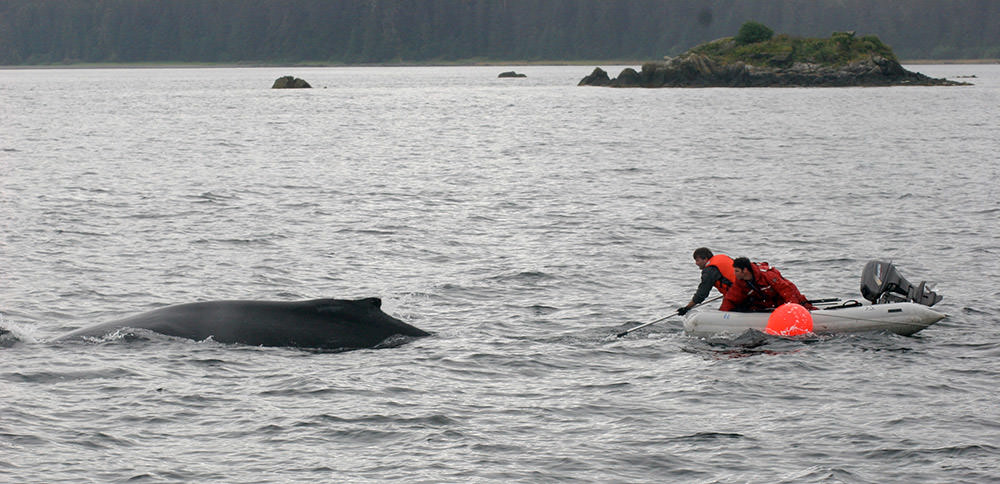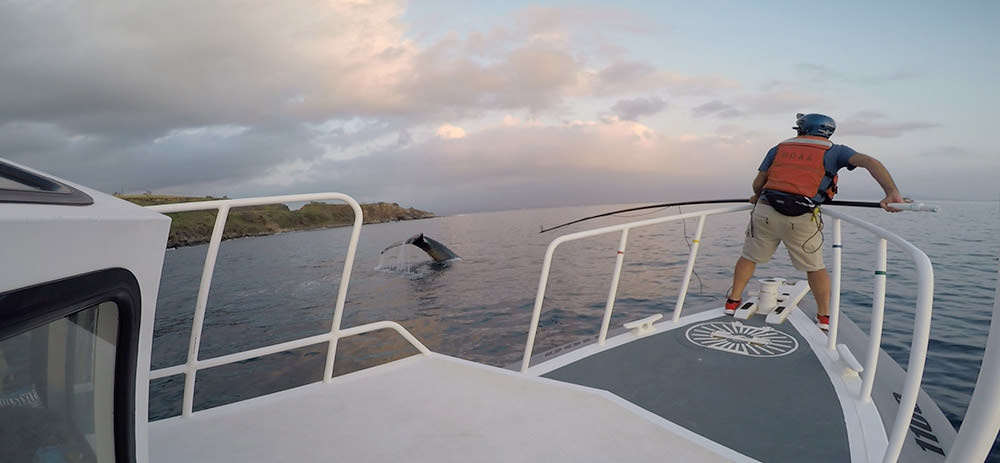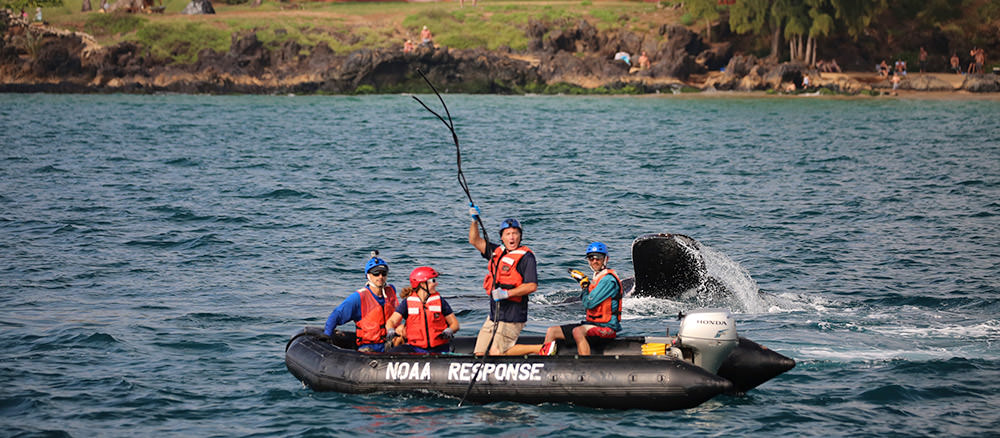Disentangling Giants: Hawaiian Islands Humpback Whale National Marine Sanctuary Combats Unintended Catch
By Rebecca Wilken
June 2017
Despite several coastal states, including California, implementing gear recovery programs in recent years to promote retrieval of derelict nets, tons of debris remains in our sea. Carried on ocean currents, fishing debris can travel across the globe. Wherever it goes, this traveling debris can entangle marine life like humpback whales.
To combat the threat of entanglement, NOAA's Office of National Marine Sanctuaries and our partners have been working to remove marine debris and disentangle trapped animals. Over the years, "the efforts have gotten more organized and coordinated," says Ed Lyman, resource protection and response coordinator at Hawaiian Islands Humpback Whale National Marine Sanctuary. Just this spring, community members completed a successful disentanglement off of Maui, Hawai'i with the help of an unexpected partner all the way from the East Coast!

Hawaiian Islands Humpback Whale National Marine Sanctuary leads the Hawaiian Islands Entanglement Response Network. The network is overseen by NOAA Fisheries' Marine Mammal Health and Stranding Response Program, and includes partnerships with NOAA Fisheries, the state of Hawai'i Department of Land and Natural Resources, the U.S. Coast Guard, as well as whale researchers, Hawai'i's tour industry, fishermen, and others to coordinate large whale entanglement responses around the Hawaiian Islands.
Lyman notes the utility of such a vast network, stating that "At 45 feet, the average length of a humpback whale, it still ends up being a needle in a haystack. The ocean is a large place! Having the on-the-water community report makes it possible to locate entangled whales and helps us respond safely. Since 2002, the network has a mounted over 155 on-water or in-air responses."

On March 11th, 2017, reports started coming in to the Hawaiian Islands Entanglement Response Network from concerned locals about a possible entanglement. A humpback whale was exhibiting odd behaviors near the Pali Lookout on Maui. That same morning Tasia Blough, research specialist at Stellwagen Bank National Marine Sanctuary in Massachusetts (also a popular site for humpback whales), had scheduled to meet with Lyman.
Blough, too, had noticed the whale resting off Pali Lookout on the way to their meeting, but at that time the whale hadn’t been exhibiting any unusual behaviors. With calls coming in, the two researchers set out to observe the whale and confirm the reported entanglement.
"It was an interesting case because at first, there weren't any visible signs of entanglement," Blough says. "Finally I saw a slight bit of yellow at the side of its jaw. I didn't know what it was but we didn’t want to risk it."
Lyman called in an official on-water response with the Hawaiian Islands Entanglement Response Network and, within hours, an authorized response team with support from the U.S. Coast Guard began working to free the whale. They worked right up until dusk, when the team was forced to terminate their efforts for the night.
Bright and early the following day, the team returned on board the R/V Koholā, the sanctuary's research and response vessel designed specially for working around large humpback whales. Vessels like Koholā can be invaluable in disentanglement efforts, enabling responders to minimize response time and carry all the gear they will need to safely respond.
Blough, Lyman, and a number of fellow responders worked tirelessly to sweep hanging gear from the whale's mouth, but traditional tools weren't cutting it. Exemplifying the important support role locals and other members of the public can also play in disentanglement events, the team called in a volunteer to help pick up new supplies from a local hardware store, Eventually, the team freed the whale from nearly 800 feet of ⅝-inch coaxial, communications-type cable — with a brand new pair of bolt cutters.

Although some cable remained in the whale's mouth, the whale eventually swam out to deeper waters exhibiting improved behavior and free swimming. Because of the excellent communication between all parties who played a role in this young whale’s disentanglement, the humpback whale's prospects are good and chances at survival are far improved.
That expert communication — between Blough and Lyman, the U.S. Coast Guard, Maui Ocean Safety, Kahoolawe Island Reserve Commission, local tour operators, volunteers, and two national marine sanctuaries — is what makes programs like the Hawaiian Islands Entanglement Response Network a success of humpback proportions.
The network has now freed more than 23 whales from all or significant amounts of entangling gear, and in the process removed more than 10,000 feet of gear from the animals. With the most recent disentanglement at Pali Lookout in mind, the potential of the Hawaiian Islands Entanglement Response Network to strengthen relationships among sanctuaries, and between sanctuaries and their local communities, is evident.

The recent rescue effort off Pali Point "created a connection," Blough says. "It’s a great learning experience to see how other teams do things. Whales in New England face entanglement issues too — and it’s an uphill battle. Getting to see how the Hawai'i team responds, working together and with communities to use the best resources and techniques we have, is the way to go."
Coastal communities across the country face many similar challenges like entanglement and marine debris. Lyman adds that "The goal is not just to free whales, but to gain information to reduce the threat in the future. To that end, we have gone a long way towards identifying the gear, where it came from, how was it set, and more." Answering these questions could help reduce the amount of gear and debris in our oceans, and to help create more whale-safe gear for the future.
In Stellwagen Bank National Marine Sanctuary, Blough notes that some groups are working with different colored fishing lines to see if whales are better able to avoid gear of a certain color. The fishing community "is very willing to try new things," she states, noting that growing connections not only between sanctuaries but with local fishing communities and others is an essential step in tackling the issue of humpback whale entanglements.
"When you go out on a whale watching boat, you see that most of those whales have entanglement scars on their body. It’s happening to a large portion of the population each year." Blough says. But finding ways to better communicate the issue with the public and share strategies that work among trained groups can help.
If you find an entangled whale, don't try to help it yourself — that can be dangerous for both you and the whale. If you’re in Hawai'i, start the chain of communication by calling the regional NOAA Fisheries Hotline at (888) 256-9840 or reaching out to the US Coast Guard at VHF Channel 16. If you’re outside Hawai'i, you can find contact information for your local stranding network here. Though it may require the coordinated effort of many professionally trained individuals to disentangle humpback whales, reports from the public can be essential in initiating timely responses. By coming together, we can protect humpback whales from derelict gear for generations to come.
Rebecca Wilken is a social media intern for NOAA's Office of National Marine Sanctuaries.

